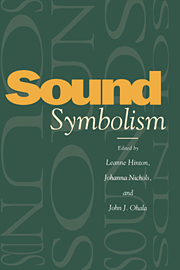Book contents
- Frontmatter
- Contents
- List of contributors
- 1 Introduction: Sound-symbolic processes
- PART I Native American languages north of Mexico
- PART II Native languages of Latin America
- PART III Asia
- 8 i: big, a: smal
- 9 Tone, intonation, and sound symbolism in Lahu: loading the syllable canon
- 10 An experimental investigation into phonetic symbolism as it relates to Mandarin Chinese
- 11 Palatalization in Japanese sound symbolism
- PART IV Australia and Africa
- PART V Europe
- PART VI English
- PART VII The biological bases of sound symbolism
- Index
9 - Tone, intonation, and sound symbolism in Lahu: loading the syllable canon
Published online by Cambridge University Press: 04 August 2010
- Frontmatter
- Contents
- List of contributors
- 1 Introduction: Sound-symbolic processes
- PART I Native American languages north of Mexico
- PART II Native languages of Latin America
- PART III Asia
- 8 i: big, a: smal
- 9 Tone, intonation, and sound symbolism in Lahu: loading the syllable canon
- 10 An experimental investigation into phonetic symbolism as it relates to Mandarin Chinese
- 11 Palatalization in Japanese sound symbolism
- PART IV Australia and Africa
- PART V Europe
- PART VI English
- PART VII The biological bases of sound symbolism
- Index
Summary
Feature shuffling and tonogenesis in Sinospheric languages
The development of full-fledged tonal systems of the “omnisyllabic” type seems to be unique to East and Southeast Asia. In a language with an omnisyllabic tone system, virtually every syllable occurs with a distinctive tone that is not predictable either in terms of the syntactic structure of its phrase or phonotactically in terms of neighboring syllables. These tones are not just oppositions of higher vs. lower pitch, but are complex bundles of prosodic features including pitch, contour, vowel length, and “phonation type” (clear, creaky, breathy voice). Omnisyllabic tone languages usually have a minimum of three distinctive tones, and some have as many as 10 or 12.
There appears to be a necessary connection between omnisyllabic tone and monosyllabic morphemes. The stronghold of these tone systems is precisely the monosyllabic languages that are typologically similar to Chinese: what I have called the “tone-prone” or “toniferous” languages of the “Sinosphere.” Some of these languages are genetically related to Chinese (those of the Tibeto–Burman family), but others (Tai, Hmong-Mien [Miao-Yao], Vietnamese) have developed their tones – and indeed their monosyllabicity – secondarily, through contact influence from Chinese.
Diachronically, the development of tonal contrasts – tonogenesis – has been shown to result compensatorily from losses or mergers in the consonantal system. Loss of a voicing contrast in pre-vocalic consonants can be transphonologized into a contrast between higher and lower tones; while loss of a postvocalic laryngeal (-? or -h) can lead to a phonemic contrast between rising and falling tone.
- Type
- Chapter
- Information
- Sound Symbolism , pp. 115 - 129Publisher: Cambridge University PressPrint publication year: 1995
- 5
- Cited by



